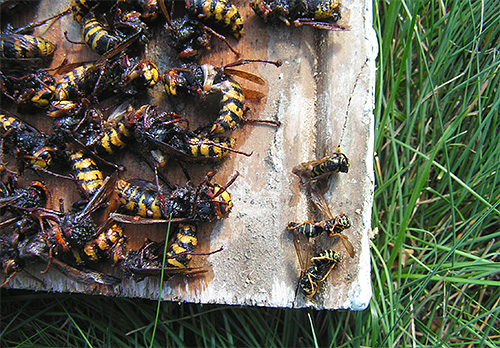
The basis of the diet of hornets is mainly insects. That is why hornets and wasps are good helpers of a gardener or gardener in the fight for the harvest. They are able to destroy a significant number of insects harmful to cultivated plants, and often those that are not eaten by birds.
However, such assistance is good only on the condition that the wasps and hornets themselves settle somewhere in the district, and they fly to the site only to collect food. If these insects decide to settle right near the house, and in the worst cases - indoors or right in the yard, they need to be removed, since such a neighborhood poses a real danger to human health. To get rid of such unpleasant guests, a hornet trap is usually used.


On a note
For a person with high sensitivity to insect venoms, one wasp sting, and even more so a hornet sting, can be deadly. Hornet and wasp venom causes a powerful allergic reaction and can even lead to anaphylactic shock. These insects pose the greatest danger to children - in the event of serious bites, the child may develop sensitivity, and stinging insects will pose a great danger to him for life.
In each case, you need to be able to choose the right method to deal with wasps and hornets.

Often it is the trap that becomes the best way to get rid of them. However, as they say, every rule has its exceptions...
Review
“I caught hornets in my area with a simple plastic bottle. We cut off the top of it, turn it upside down and insert it into the bottom half. Before that, I poured a glass of beer there and added honey. In a week I caught a little more than 20 hornets, and today 2 more.
Alexander, Kursk
When traps are better than other ways to fight
The wasp and hornet trap is ideal for trapping insects in areas where there is no nest. The explanation for this fact is simple - if the hornets do not return to their home from the garden or garden due to falling into a trap, in a few weeks they will completely stop visiting this place.
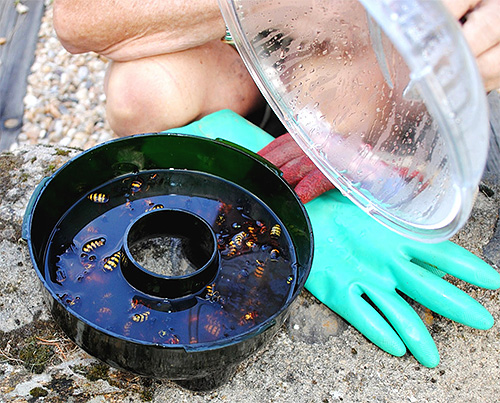
But to catch a hornet in an apiary is a more difficult task, since baits for it can also attract bees. In addition, the hives themselves are a more desirable object for these predators than the usual honey bait.
To protect the apiary, it makes sense to first find the very location of the hornet nest and hang the trap directly next to it. With proper observation, it is quite easy to determine where the hornet lives - as a rule, this insect settles in forest stands near agricultural land, so their nest can sometimes be found in just one excursion.
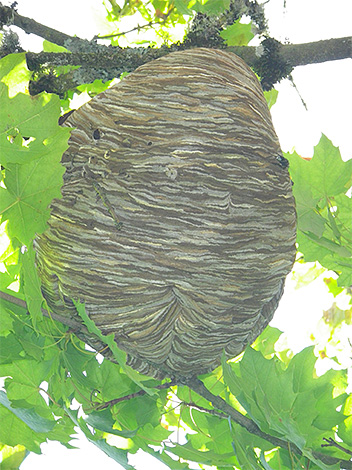
Review
“Somehow, in my youth, I drove hornets from the site and looked for their nests. An interesting process, but tedious. Find a hornet, catch, mark, track down ... But it works for sure. Now I only hang traps near their evidence, but immediately, since April.Result: the hornets never touch the apiary. But they are caught regularly until the end of the summer, and in large numbers.”
Igor, Kyiv
In addition, the trap for wasps and hornets can be used in all situations where there is no hurry to remove these insects. For example, it makes sense to fight wasps during a period when the summer cottage is not visited. In this case, the trap can be hung here and left for several weeks, and during the next visit, just throw out the caught insects.

However, there are situations when hornets and wasps need to be caught quickly and immediately: they can interfere with the work necessary in the country or frankly harm the apiary. In this situation, their homes should be destroyed as quickly as possible. To do this, at night, it is necessary to remove the nest itself and lower it into a bucket with a rag moistened with ammonia. The second option for extermination is to simply treat the removed nest with insecticidal preparations.
Nevertheless, despite the seemingly simple ways to deal with hornets, there are cases when the Ministry of Emergency Situations had to be called to destroy the nests of these insects. Fortunately, such situations are quite rare, and in the fight against wasps and hornets, in most cases you can get by with traps.
How and from what to make a trap
The simplest, but no less effective traps for wasps and hornets are made from improvised materials.
Let's see what and how exactly can be used for these purposes:
- A plastic bottle - its upper third is cut off, sweet bait is poured into the lower part. Next, the cap is unscrewed, and the top of the bottle is turned over and installed in its lower part.Thus, a funnel is obtained, into which hornets and wasps easily crawl, but they cannot get back, because they are looking for a way out along the edges of the walls. You can supplement the resulting design by lubricating the neck of the bottle with petroleum jelly. With such an improvement, even particularly resourceful specimens will not be able to cling to the neck and get out of the trap.

- A similar design is made from a glass jar with a screw cap. In this case, a cross is cut out in the lid with a strong knife, the corners of which are wrapped inward, after which the bait is poured into the bottom of the jar.
- To make a slightly more complex trap, you will need a galvanized sheet cylinder. A funnel made of fine metal mesh is inserted inside it with a narrow neck up. The top of the funnel should be no higher than 10-20 cm from the top edge of the cylinder. This whole structure is installed on bricks, and on top it is covered with an old sieve or a sheet of fine mesh. In order to catch a hornet or a wasp, you need to put a piece of meat or fish under the cylinder. As a result of all these manipulations, insects flock to the bait, attracted by the smell of food, feast on it and instinctively fly away, rising up. Through the funnel, they fall into the upper part of the cylinder and, to the point of exhaustion, beat there against the upper grid. In this trap, they can be poisoned every few days with any insecticidal agent.

Finally, for those who, for some reason, cannot make a trap for wasps and hornets on their own or doubt the success of the business, today there are a number of special factory-made devices on sale that allow you to catch insects without much time and effort. It is only important to use these traps correctly.
How to attract hornets and wasps
Wasps and hornets can be attracted to a wide variety of foods, from fruit to spoiled fish. Practice shows that the most attractive baits for them are:
- a mixture of beer and honey or just sweetened beer
- syrup with a strong odor
- fermented raspberries or grapes
- fish.
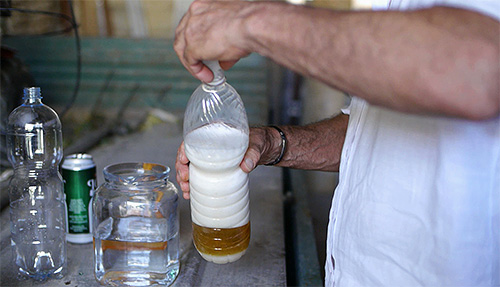
Of course, in each specific case, it is necessary to use exactly the bait that will not disturb the atmosphere of the place. For example, even those wasps that would never visit the site will flock to fish with a smell, but it’s not very pleasant for a person to be near such a bait.
When and how to catch pests
The best time to place traps is in spring, as during this period, only young queens and the first individuals of a new brood fly. If these hornets and wasps are caught, the family they belong to will perish.
Catching wasps at the end of summer is usually not the most effective business, although there are a lot of insects at this time and they are very annoying. This is explained by the fact that the use of any means of trapping, even the most advanced, does not guarantee a person the capture of all members of a huge family. At this time, the traps will only work as a limiter to the number of hornets and wasps on the site.
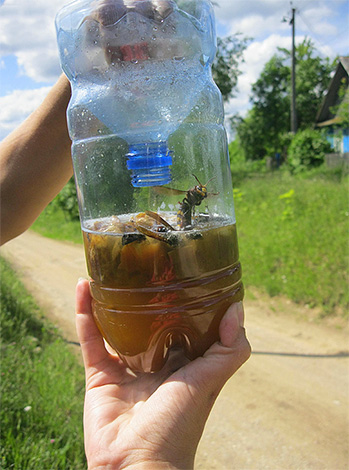
Review
“In spring, I surround the entire apiary with hornet traps. I usually make them from bottles, and I use beer with sugar as bait. I tried imported traps, but the result is the same, only they cost several times more. Until June, hornets come across in them, then they stop. And that’s it, not a single piece of evidence has ever been damaged by me.”
Sergei Petrovich, Tuapse
Another important advantage of placing the trap on the site in the spring is that it will not allow insects to initially settle here.Wasps and hornets will first of all fly into it to feed, but they will not be able to fly back.
Safety precautions when using traps
So, a hornet or a wasp has already been caught, but, nevertheless, they remain dangerous until their death. Contact with the trap, without fear of being stung, is possible only if the insects are dead. If the wasps or hornets are still crawling, it is enough to sprinkle them with any means for removing cockroaches, and only then, after making sure that the insects have died, proceed to empty the trap.
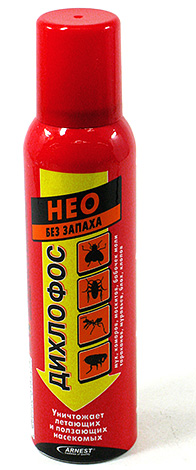
Extreme care must be taken when placing and checking traps located in close proximity to insect nests. Here, hornets can attack if they think that a person is threatening their nest. That is why you should not place the trap closer than 20 m to the dwelling of insects, because. at such a distance, the wasps will easily smell the bait, but they will not attack the person placing it.
Review
“We have a neighbor who was fond of such things with hornets. I put bottles, some buckets. Once a hornet hit him in the neck, the ambulance barely had time to take him to the intensive care unit. The wife could not stand it and called the Ministry of Emergency Situations. The guys arrived, with jokes and jokes, they smashed all the rubbish in the attic in his shed, put the nest from under the roof into a bucket and filled it with bleach. So they brought it out."
Andrey, Moscow region
Despite the seriousness of the situation with hornets and wasps that settle in the immediate vicinity of human habitation, the main thing to remember is that when catching these insects, you should not get carried away and exterminate them simply because they exist. In our country, the hornet is an insect with a steadily declining range, listed in some regional Red Books.
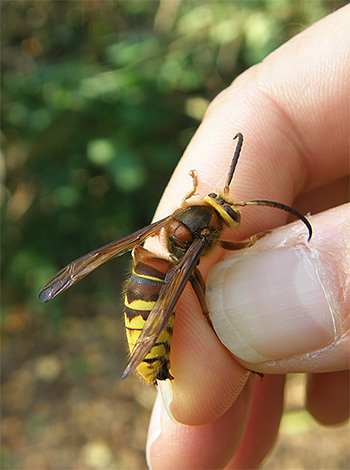
This means that these insects should be destroyed only when they really interfere with economic activity and pose a danger to humans. In other situations, hornets and wasps are excellent assistants to gardeners and gardeners in pest control. So work and live in harmony with nature.
We make a trap for wasps and hornets with our own hands
Plastic bottle with syrup inside as a trap to protect the hives


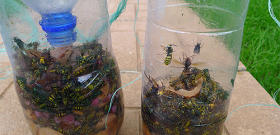
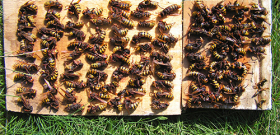
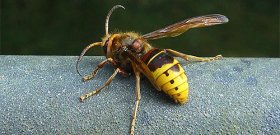
We also somehow got hornets on the site, and I did everything exactly as it is written in the article. I made a trap from a plastic bottle and poured beer into it. As a result, some hornets came across, but still a lot of them flew around the site. Then I did some reconnaissance and found their nest.As my friends later told me, the whole point is to destroy the uterus of the hornets - it is she who lays eggs, and the working hornets regularly bring food for them. She did not react to the smell of beer, so I took and poured plastic directly into this trap half a 1.5 liter can of liquid honey. And wow, literally on the same day, the uterus of hornets (it was definitely she, judging by the size) got out of the nest and fell into a trap. And indeed, after that, the rest of the hornets were very easy to catch. Maybe your case, of course, is not like that, but only such a tool helped us.
Thanks, good article.